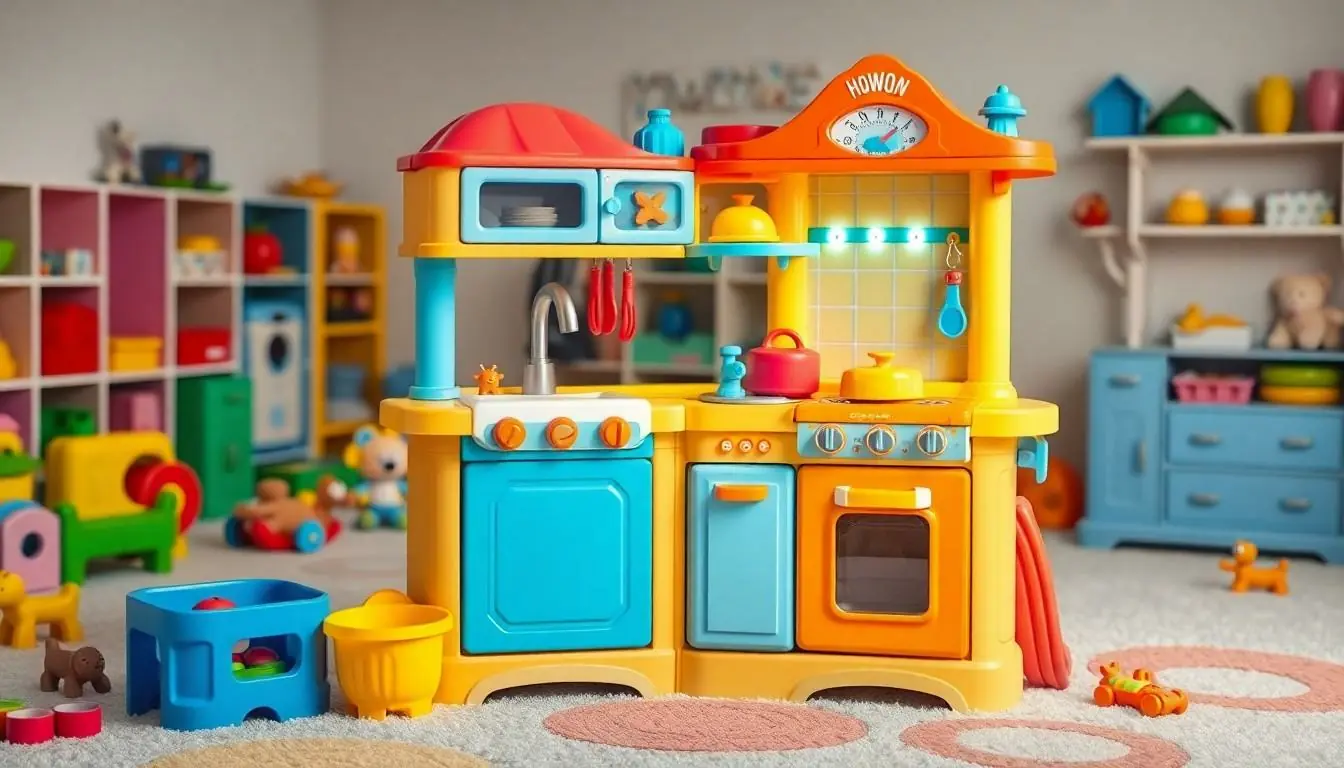Table of Contents
ToggleImagine a world where tiny chefs whip up gourmet meals while you sip your coffee in peace. Kids kitchens are the magical portals that transform playtime into culinary adventures. These miniature cooking spaces spark creativity and imagination, allowing little ones to explore their inner Gordon Ramsay—minus the yelling, of course.
With a kids kitchen, every day can be a new recipe for fun. Whether they’re baking pretend cookies or serving up imaginary spaghetti, these playsets not only keep kids entertained but also teach them valuable skills. Plus, they might just inspire the next generation of food enthusiasts. So why not let them stir up some joy in their own little kitchen? After all, who wouldn’t want a sous-chef who’s more interested in play than in making a mess?
Overview of Kids Kitchens
Kids kitchens represent a captivating blend of fun and education, turning ordinary playtime into a canvas for imagination. These miniature cooking stations feature realistic designs with items like pots, pans, and utensils, allowing children to mimic real-life cooking scenarios. Engaging in pretend play with these kitchens encourages creativity and boosts problem-solving skills while sparking an interest in culinary arts.
When children engage in cooking activities, they practice important life skills. Role-playing as chefs can enhance fine motor skills through actions like stirring or serving. Parents often notice improvements in hand-eye coordination as kids manipulate utensils and ingredients during play.
Additionally, kids kitchens foster social interactions. Playing together encourages teamwork and communication among peers, making cooperative play an essential aspect of their development. Through sharing tasks, children learn how to resolve conflicts and develop empathy for others.
Safety features in modern kids kitchens contribute to worry-free play. Many brands prioritize materials that are non-toxic and designed for durability, reassuring parents about their children’s safety.
Variety exists in the types of kids kitchens available on the market. Options range from compact, portable designs to elaborate setups complete with sound effects and lights. With numerous styles and themes, kids can choose kitchens that match their interests, further making playtime enjoyable and tailored.
Kids kitchens stimulate both fun and learning. They serve as valuable tools for children’s development, blending play with practical skill-building in a safe, creative environment.
Types of Kids Kitchens

Kids kitchens come in various styles, allowing children to experience different cooking scenarios. Each type offers unique benefits that enhance imaginative play while supporting skill development.
Wooden Kids Kitchens
Wooden kids kitchens provide durability alongside a classic aesthetic. These kitchens typically feature sturdy construction, ensuring they withstand rigorous play. Engaging textures and colors enhance sensory experiences. Many wooden kitchens come equipped with realistic accessories, encouraging children to mimic real-life cooking. Customizable designs allow for personalization, appealing to various interests. Environmentally friendly materials often used in their production assure parents of safety. Wooden kitchens contribute to a sense of nostalgia, creating a timeless play experience that fosters creativity.
Plastic Kids Kitchens
Plastic kids kitchens offer lightweight options ideal for easy mobility. Many of these kitchens integrate vibrant colors and modern designs that attract children’s attention. Resilient materials resist wear and tear, ensuring longevity through countless imaginative meals. Often, plastic kitchens include sound effects and lights to simulate cooking, enhancing engagement. Conveniently cleaned and maintained, these kitchens suit busy households. Variety in themes, such as fast food or gourmet styles, caters to diverse preferences. Plastic kids kitchens enable dynamic play while providing safety features parents appreciate.
Features to Consider
Selecting the right kids kitchen requires attention to specific features. Size and safety are crucial factors.
Size and Space Requirements
Space considerations play a major role in choosing the perfect kids kitchen. Compact designs suit smaller rooms, while larger kitchens provide more play area. Heavier playsets often necessitate stable surfaces. Additionally, some setups come with removable parts for easy storage. Children can engage in imaginative play in various settings, including bedrooms and playrooms. It’s wise to measure the intended area before making a purchase. Prioritizing these spatial elements ensures a comfortable and enjoyable experience for kids.
Safety Standards
Safety standards define quality in kids kitchens. Products made from non-toxic materials enhance child safety during playtime. BPA-free plastics and solid wood options remain popular among parents. Many brands follow rigorous safety testing guidelines to ensure durability and reliability. Pay attention to age recommendations when selecting a kitchen to match children’s developmental stages. Features like rounded edges and sturdy construction further minimize risks. Being aware of these safety aspects contributes to a worry-free environment for both parents and children.
Benefits of Kids Kitchens
Kids kitchens offer numerous benefits that contribute to a child’s growth and development. They serve as engaging tools that foster creativity and learning.
Encouraging Imaginative Play
Kids kitchens spark imaginative play by allowing children to mimic real cooking scenarios. During this play, kids often create their own recipes and serve pretend meals to family and friends. These activities contribute to storytelling skills and promote fantasy-based scenarios, enriching their creativity. Given the variety of themes these kitchens provide, children can explore different cultures or culinary styles, enhancing their understanding of the world. Children can easily adapt their play, building unique narratives each time they enter the kitchen. This endless creativity makes kids kitchens an invaluable resource for nurturing a child’s imagination.
Developing Motor Skills
Kids kitchens are instrumental in developing fine motor skills essential for everyday activities. Children engage in various movements like stirring, pouring, and chopping using play utensils, which strengthens hand-eye coordination. Frequent use of kitchen accessories enhances dexterity, helping kids perform tasks requiring precision. These activities also introduce basic concepts of measurement, improving cognitive skills while they play. Each interaction with the kitchen not only promotes physical development but cultivates confidence in their abilities. Encouraging independent play in this manner prepares children for future cooking experiences, making these kitchens beneficial for skill-building.
Top Kids Kitchens on the Market
Various kids kitchens on the market cater to different preferences and play styles. The KidKraft Uptown Espresso Kitchen features an elegant design, complete with modern appliances like a refrigerator and microwave. Its realistic sound effects bring cooking to life, making it a popular choice among young chefs.
Next, the Step2 Cozy Kitchen stands out with its bright colors and ample storage. This kitchen encourages collaborative play with multiple children as they prepare imaginary meals together. Parents appreciate its durability, made from sturdy plastic that withstands rigorous play.
The Melissa & Doug Wooden Chef’s Kitchen offers a classic wooden design that enhances creativity. This kitchen includes chalkboard surfaces and detailed accessories. Children enjoy mimicking cooking experiences while developing storytelling skills in a warm, inviting space.
Another exceptional option is the Little Tikes Super Chef Kitchen, which combines interactive features with vibrant aesthetics. It includes lights and sounds, along with various cooking tools to spark imaginative scenarios. The design accommodates several children, promoting social interaction during playtime.
For those who prefer modern flexibility, the Hape Gourmet Kitchen is here. It combines a sleek design with eco-friendly materials, making it suitable for environmentally conscious families. Children can experiment with their culinary skills while parents feel secure about safety standards.
Lastly, the Plum Play Wooden Role Play Kitchen emphasizes sensory experiences and realism. Its interactive elements allow children to explore cooking ideas, deepening their engagement. This kitchen supports fine motor skill development through playful coordination exercises.
Each of these products showcases unique features and themes, providing children with opportunities to learn through imaginative play. Choosing the right kids kitchen enhances playtime, fostering creativity and skill development in an enjoyable and safe environment.
Kids kitchens offer a delightful way for children to engage in imaginative play while developing essential skills. These playsets not only spark creativity but also foster social interactions and enhance fine motor skills. With a variety of designs and materials available, parents can find the perfect kitchen that matches their child’s interests and space requirements.
Safety features ensure worry-free play, allowing kids to explore culinary adventures without concern. As children mimic real-life cooking scenarios, they build confidence and prepare for future experiences in the kitchen. Ultimately, kids kitchens serve as invaluable tools for nurturing creativity and learning in a fun and engaging environment.



